Our Big India Adventure begins…
This year we cashed in our Delta skymiles for two round trip business class tickets to Southern India for a month. We decide to improvise this trip rather than having everything all set up, so we can trawl around at our own pace.
¥†¥
It is February 17. We are picked up at the airport by a smiley man named Bijoy, who along with his wife Nisha owns the homestay we have chosen. Mark and I both take to his easy charm. He explains on the very short drive (the homestay is literally behind the airport) that we are his first guests … ever. Only last week did the workers put finishing touches on the place to prepare for our arrival. He is curious how we heard of his homestay. “The internet” Mark replies, for indeed it was their webpage that brought us to “The Nutshell¨
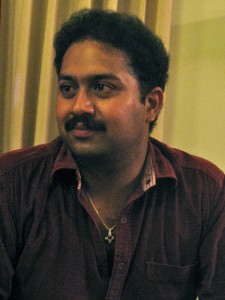

Bijoy and Nisha also own the pretty house in front of where we’ll be spending the next few nights. This is where Bijoy´s parents live. His mother is the official homestay cook. Our place is filled with fascinating Keralan antiques which she has collected over the years.
After we unpack our bags and get settled it is time for lunch. When asked if we would like Keralan food we in unison say “sure!”. When lunch is served we meet Bijoy’s wife Nisha, who is the partner and creative brains behind the homestay. We learn later she is also the producer of a popular TV station (Asianet), but is on leave because of a tragedy; she recently had a miscarriage and was given a one month leave of absence. Over the next few days I have lots of intensely educational and personal exchanges with both her and Bijoy on the topic of family duty. Neither one of them really wants a child, for Bijoy is trying to get his degree in the UK and Nisha is happy running her TV station; they undergo disruptive fertility treatment for the sake of his parents. I think Nisha finds my opinions on childbearing and responsibility to one’s parents refreshing, for my life is a convincing argument as to why not everyone should have children. I am happy, traveling and feel way younger than my years. Life is fun with no one to answer to.
We are also introduced Bijoy’s mother, who is the cook. She is a tiny, hardworking, quiet but forceful character. She reminds me of my Italian great-grandmother, Nonna Lina, who also had a tiny frame but a subtly forceful character. I take to her immediately and the affection is mutual. Her name is Chandrika Devi. but I’ve decided to call her Nonna Devi.
The food comes in lots of bowls, each one a different a type of curry, curd sauce with chili peppers, many delicious unidentifiable vegetables dishes, some fried fish and lots of rice. This is our first Keralan meal and Nonna Devi is eager to teach us to eat traditional Kerala style, with our right hand only, no utensils. Having read about this in our Rough Guide, I imagined it would be easy, but it is a foreign feeling to eat food with your hands after the natural instinct has been trained out of you since childhood.

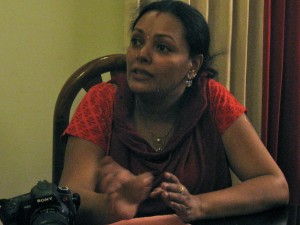
Nonna Devi is a tiny woman who works incredibly hard. She watches over us as we lamely try to shovel food into our mouth using only one hand. The look on her face seems to say “How have you people survived this long, you seem intelligent yet you cannot even feed yourselves”.
She gets a real kick out of our efforts. After getting over shoveling food into our mouth with one hand we then have to deal with the fact that we cannot use our left hand in the eating process at all. You only have the one hand to tear bread and pull apart your meat and scoop up your vegetable curry and rice. After three days and a few lessons from the impatient elders. “Mix it up and make a ball and then pop it in your mouth with a chapati,” they say endlessly until we start getting the hang of it.
When asked what our plans are after Trivandrum we bring out our travel guide books and show them the places in Kerala we want to visit. Tomorrow is my birthday, which is why we’re staying at their place for 3 nights. So tomorrow my only wish is to take a swim. I have a notepad with places of personal interest, and mention that I`d like to see the Tantric snake worship temple in Mannarsala. We are told that visitors are not allowed to enter this temple, and they seem unable to understand I just want to see the temple, not go inside. Its the architecture and surrounding grounds that interests me. Nisha says, ¨Coincidentally there is to be a snake ritual this evening in a small village about a 45 minute drive from here, would you like to go? We’re going, and its a unique opportunity for you to get an authentic glimpse of Kerala culture¨. We say “sure!” as usual.
During the drive we have lots of animated conversations about many subjects and find out Bijoy and Nisha are a very similar couple to us, in temperament, age difference, and creative ability. We dub them our Indian Doppelgangers. They are both stimulating, and unexpectedly open with us about personal experiences and resulting views.
¥†¥
Kalamezhtu Snake worship ceremony.
After a one hour drive we arrive at the Snake Dance Ritual grounds, which is decked out with a stage and a walled off area filled with trees and vines and small temples to all sorts of gods and demi-gods.
There is a covered area under the trees where they are creating a huge “painting” on the ground. It is similar to a sand painting but they use different types of crushed seeds, rocks, spices, all sorts of powder to create a palette of vibrant colors. For a paintbrush they use an empty coconut.
There are 4 or 5 men working on the painting at the same time using different techniques to create and fill in the outlines. The painting itself is of a huge 5 headed snake wrapped around a jungle tree and sitting on a brick wall.
We watch the artists and listen to the storyteller that is on the stage as the guests arrive. The storyteller is a bit of a ham, laughing at his own antics. Although I don`t speak Malayan, I can tell his stories have lots of twists and turns which delight his small, elderly audience.
The whole village soon arrives in droves. There is much preparation and excitement. Little clay plots with kerosene are lighted and placed all along the road coming into the compound, along with lots of festive colored lights everywhere reminding me of Mexican luminarios.
We do a bit of standing around. All the little girls are fascinated by me and a few of them ask me basic questions in English, obviously learned at school.
¨What is your name? Where are you from? How old are you? Do you have children?” And the inevitable, “Are you Indian?”
We wait a while longer, then hear drums coming from up the road, as a procession arrives at the compound. There are two lines of mothers with their very young daughters, all impeccably dressed up and holding their offering to the snake god. The offering consist of food, flowers and a flame.
After the procession of little girls goes by a drum troupe passes, with very animated dancers spinning, wearing huge, peackock-like costumes.
I look up the road and see the biggest animal I have ever laid my eyes on. It is a huge elephant, I would say the top of him was over 20 feet tall. He is enormous with big soulful eyes and chains on his feet. He is followed by an equally impressive but smaller elephant. This procession goes around the compound three times to the delight of everyone in the crowd. With my NAGRA digital audio recorder for sound and only my little canon camera for photos and videos, we document the whole 5 hour ceremony.
Once the procession stops it is time for the holy man to do his thing, If you have ever seen a Hindu ritual you know that it is a very complex and intricate series of motions involving the throwing of small flowers, burning of incense, waving hands over liquids and mysterious gelatinous substances. Flames are lit and things are passed around and the women wail at certain times.
Accompanied by one-string violins, earthernware pots with one string attached to them and bell-metal cymbals, people sing along. This goes on for hours until the main holy man goes into a full on trance and starts dancing a crazy tarantella which climaxes when he falls and rolls on the ground, essentially destroying the painting which took all afternoon to complete. He is in a trance state, fascinating to watch. He is now given a machete. I question the logic of giving a machete to a man in a trance who is apparently oblivious to the world we are inhabiting and my misgivings are immediately justified, as he blindly rushes towards the crowd where we’re standing, waving the machete. As I film it with my little camera, we lunge backwards to escape the mad man. Fortunately he stops at what looks like a yucca or palm plant that has bloomed and he hacks at the stem until the bloom falls.
And that is the official end of the ceremony. After this people pretty much just stand around. We are the only non-natives but somehow we fit in.
From what we can tell, part of the ceremony might be the Hindu equivalent to a First Communion for little Catholic kids. We are told that they have a raffle afterwards with plenty of prizes for everyone for being such good little girls.
Every year a random person in the audience gets possessed by the spirit of the snake during this ceremony. This year it was a lady sitting directly next to Nisha . It scared the hell out of Nisha, because she was exchanging pleasantries with this lady when she suddenly fell to the ground and began rolling around. Holy men come running up to her to pour water and coconut juice on her head to keep it cool, as the spirit enters through the top of the head and can really heat it up. Once the lady comes to she has no recollection of having dropped into a trance. What’s interesting is that this lady was not involved with the ceremony, was only there for the social gathering.
There is a full moon on my birthday eve. What exceptional timing and good luck!
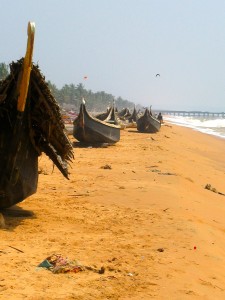

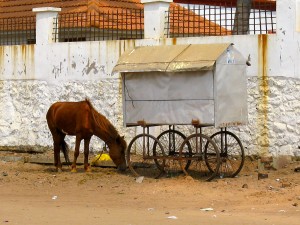


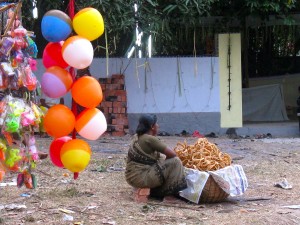


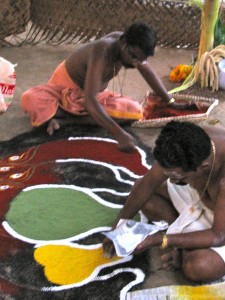







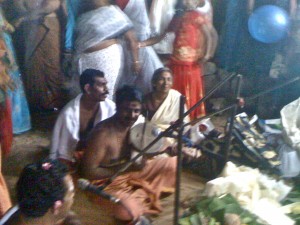
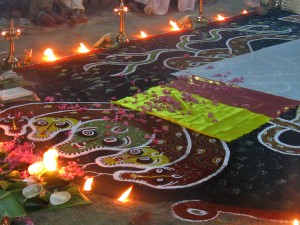
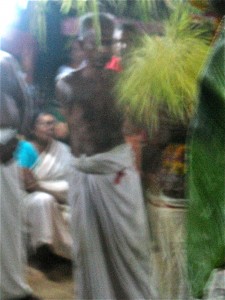





Recent Comments